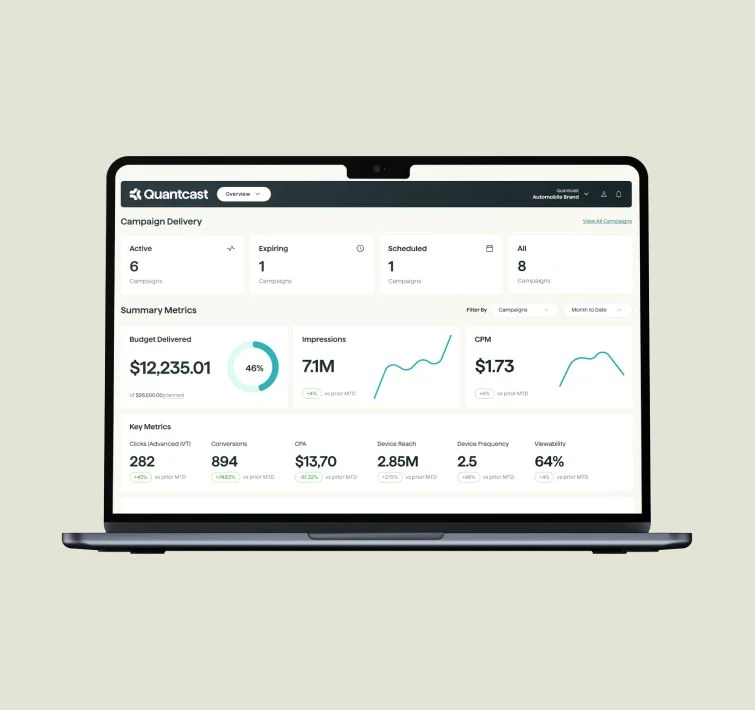Inside the Quantcast Platform: Planning and Activating Your Ad Campaigns

Written By
Diana Sull

Capture a holistic picture of audience behaviors, discovering valuable insights with psychographic, browsing interest, and attitudinal data to elevate your marketing strategies.
To deliver an effective customer experience, marketers must first understand their audiences. As customer expectations continue to increase, having a holistic picture of their behaviors is necessary to meet their needs. For marketers, discovering valuable audience insights–including psychographic, browsing interest, and attitudinal data–is vital to elevate marketing strategy and reach audiences at scale to deliver superior business outcomes.
Because audiences are always evolving, marketers need to find customers based on real-time audience behaviors. Relying on disparate data sources that can be scaled and loosely classified segments based on third-party data makes it more challenging to find the right customers at the right price. If, for instance, I enjoy running and run every day, but I am taking a cruise tomorrow, my preferences may temporarily change. Instead of drawing on stale data that may be outdated and irrelevant, marketers should be accessing real-time data that allows them to stay on the pulse of ever-changing consumer behavior and interests.
The Quantcast Advertising Platform uses real-time data from 100M+ diverse online sources to uniquely score and measure each individual impression, adjusting thousands of variables automatically. Powered by our AI and machine learning engine, it provides an up-to-the-second understanding of audience behavior and interests, which allows marketers to deliver perfectly timed and uniquely relevant advertising. You can plan, activate, measure, and innovate ad campaigns in a single unified platform.
Planning Your Ad Campaign
For our ad campaign walk-through using the Quantcast Advertising Platform, let’s take a publicly traded global footwear retailer that promotes different product lines by sport. Their overall objective is to increase awareness of the brand, but specifically they want to reach females who are interested in basketball and females who are interested in tennis. They have amazing video creative that empowers women of all different backgrounds, aligning with these sports.
You would begin, simply enough, by creating an audience. That audience can be based on all internet users across the open web or your site events or DMP segments. For this example, you would first select all internet users, and then hone in on the female basketball audience. Within the platform, you can filter your audience source location and demographics, and you can select specific custom keywords to tap into audiences with niche passions based on the content they viewed online. This is based on Quantcast’s unique understanding of the web and real-time browsing behaviors. In this case, you could input “March Madness,” “NBA Finals,” and “WNBA.”
With this information, the platform shows that this audience is younger with a slightly lower income. Their browsing interests are focused on local news and government in the US and Canada:
When you focus on sports, you can see their primary interests, which extend beyond basketball to rugby, running, and the Olympics, but remain focused locally in North America.
Next, you can see which publishers are indexing the highest for this audience:
This fantastic capability can be used for your media planning, not just within digital and within this platform, but also for your omnichannel strategy. If you are working on a custom sponsorship, or if you’re thinking through a consideration set for a brand awareness campaign, it’s a great tool to help you determine where your audience is spending most of their time. Our strong relationships with a variety of publishers mean that we can facilitate the deal directly as well.
Another popular tool is our keyword cloud, which constantly updates to provide real-time insights into what your audience is consuming online.
With this visualization tool, you can interpret the data intuitively. The keywords can also inform your planning and activation strategy, inspiring your creative direction. In this case, you might choose to highlight one of the players or correspond to a listed event.
In addition, you can gain other insights, such as what device the audience is using and where the audience is located as well as shopping interests, media interests, business, and occupation.
If you want to compare audiences, such as females interested in basketball and those interested in tennis, it’s easy to look for similarities and differences, directly within the platform without having to deal with a lot of manual digging. With this tool, you can visualize the overlap between the two audiences in terms of uniques.
The small overlap between the female basketball and tennis audiences suggests an opportunity to reach expansion audiences, tailoring your messaging approach for each one.
Activating Your Ad Campaign
To activate your audiences, you need to create your ad campaign, starting with its objective. For this example, you would select “reach/frequency,” since we’re aiming to reach women who are interested in sports. You would have an ad set for a women’s basketball audience and a women’s tennis audience, and you could continue to refine that audience, choosing to see women who also have kids or adding first-party audiences and DMP segments.
Then, you set your budget (daily vs. lifetime) and schedule. The ad set estimates will update to show you the potential reach, daily reach, CPM, and daily impressions. You can also adjust how the budget is spent, opting for day parting (certain days or times), running ads all the time, or pacing ads across a campaign.
Next, you easily upload creatives with a tag sheet. This capability also has a range of advanced settings:
- Viewability: set how viewable your ad is on the screen
- Frequency: determine how many times someone will see an ad within a set window
- Deals: bring your own inventory, using your deal IDs (e.g., if you have an agreement with an SSP, you can enter the ID to run on that inventory)
- Devices: choose desktop, mobile, tablet, connected TV (CTV), or audio (any or all combinations), based on where your brand does most of its business; if you are an app-first business, you would focus on mobile devices, and if your customers tend to do a lot of research before buying, you would focus on desktop devices
- Brand Safety: apply (or remove) our default “allow” list, curated for scale and performance, and our global blocklist, sites deemed not brand safe or fraudulent, which can be configured and adjusted according to your own specifications–e.g., a hotel advertiser does not want to show up next to content about bedbugs and so could use DoubleVerify’s pre-bid segments to define and select specific content categories to avoid
- IP Suppression: block certain IPs, like where your office is located
When you have finished configuring your ad set, you can save or publish it, whenever you are ready to launch your campaign. Once it is live, you can see reporting and campaign insights within a few hours, including:
- Performance (graphs with various metrics such as clicks and conversions; key events in the campaign or ad set)
- Demographics (age, level of education, etc.)
- Details (of the campaign setup)
- Insights Lab (a collection of reports on various aspects of the campaign and/or ad set)
These insights start as soon as you have activated your campaign, and because they are housed within the same area where you’re generally editing your campaign or ad set settings, you can easily make changes, allowing for maximum flexibility.
See for yourself just how easy it is to plan and activate your own ad campaigns with the Quantcast Advertising Platform.
Share article
You can't deny results

